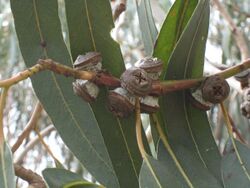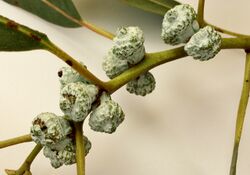Biology:Eucalyptus bicostata
| Southern blue gum | |
|---|---|

| |
| Scientific classification | |
| Kingdom: | Plantae |
| Clade: | Tracheophytes |
| Clade: | Angiosperms |
| Clade: | Eudicots |
| Clade: | Rosids |
| Order: | Myrtales |
| Family: | Myrtaceae |
| Genus: | Eucalyptus |
| Species: | E. bicostata
|
| Binomial name | |
| Eucalyptus bicostata Maiden , Blakely & Simmons
| |
Eucalyptus bicostata, commonly known as Victorian blue gum, Southern blue gum or Eurabbie[1], is a eucalypt species native to Victoria and eastern New South Wales, Australia . It grows in wet forests on fertile soils in sheltered areas in ranges away from the coast. Many botanists consider Eucalyptus bicostata to be a subspecies of Eucalyptus globulus. This is supported by the Centre for Australian National Biodiversity Research[1], the Royal Botanic Gardens, Melbourne,[2] but not by Royal Botanic Gardens, Sydney[3] where it is considered a distinct species.
Description
It is a tree growing to 40 m tall. The bark is mostly smooth, shedding in long strips to leave a white or greyish surface; sometimes with rough, partially shed bark at the base and ribbons of shedding bark in the upper branches.
The juvenile leaves are elliptical, glaucous (coated with a white waxy finish), 4 to 11 centimetres (1.6 to 4.3 in) long by 2 to 6 centimetres (0.79 to 2.36 in) wide, and are placed in opposite pairs along the branchlets for many pairs. Adult leaves are very lengthy, being 14 to 40 centimetres (5.5 to 15.7 in) long by 2 to 6 centimetres (0.79 to 2.36 in) wide, tapered or curved in shape, green and glossy.[1]
The inflorescence is distinctive among eucalypts, being large, glaucous (waxy white), "top-shaped" buds to 1.8 centimetres (0.71 in) long by 1.4 centimetres (0.55 in) wide. Buds have two longitudinal ribs and are grouped in umbels of three, producing white flowers generally between January and March in the Southern Hemisphere. The fruit (gumnuts) are large, hemispherical, stalk-less, and 0.7 to 1 centimetre (0.28 to 0.39 in) long by 1.3 to 2.2 centimetres (0.51 to 0.87 in) wide.[1]
Its name is derived from the Latin bicostatus, "two-ribbed", referring to the buds and fruit.[1]
Gallery
References
- ↑ 1.0 1.1 1.2 1.3 1.4 "Eucalyptus globulus subsp. bicostata". Centre for Australian Biodiversity Research. http://keyserver.lucidcentral.org:8080/euclid/data/02050e02-0108-490e-8900-0e0601070d00/media/Html/Eucalyptus_globulus_subsp._bicostata.htm. Retrieved 17 April 2018.
- ↑ "A Census of the Vascular Plants of Victoria". Royal Botanic Gardens, Melbourne. http://www.rbg.vic.gov.au/dbpages/viclist/cd/.
- ↑ "Flora of New South Wales". Royal Botanic Gardens, Sydney. http://plantnet.rbgsyd.nsw.gov.au/floraonline.htm.
Wikidata ☰ Q12839324 entry







